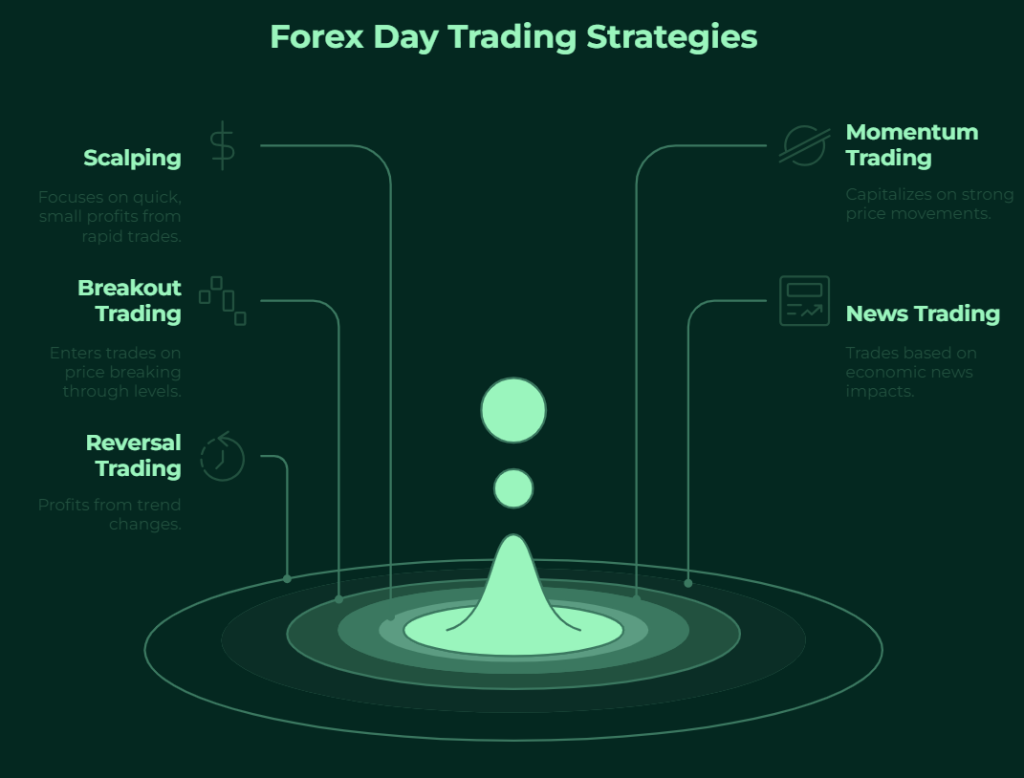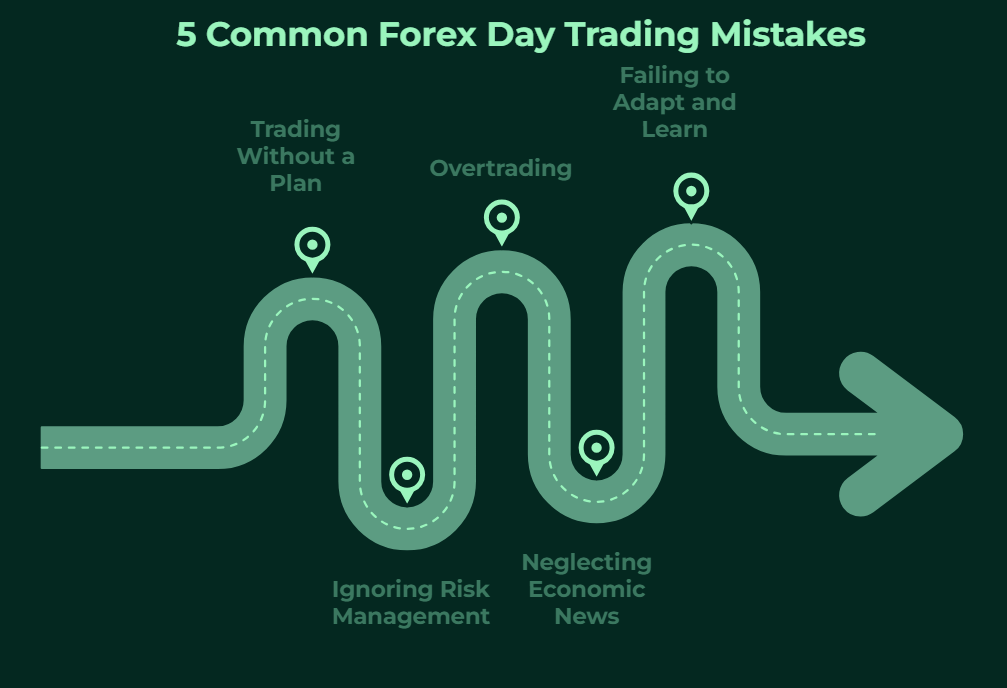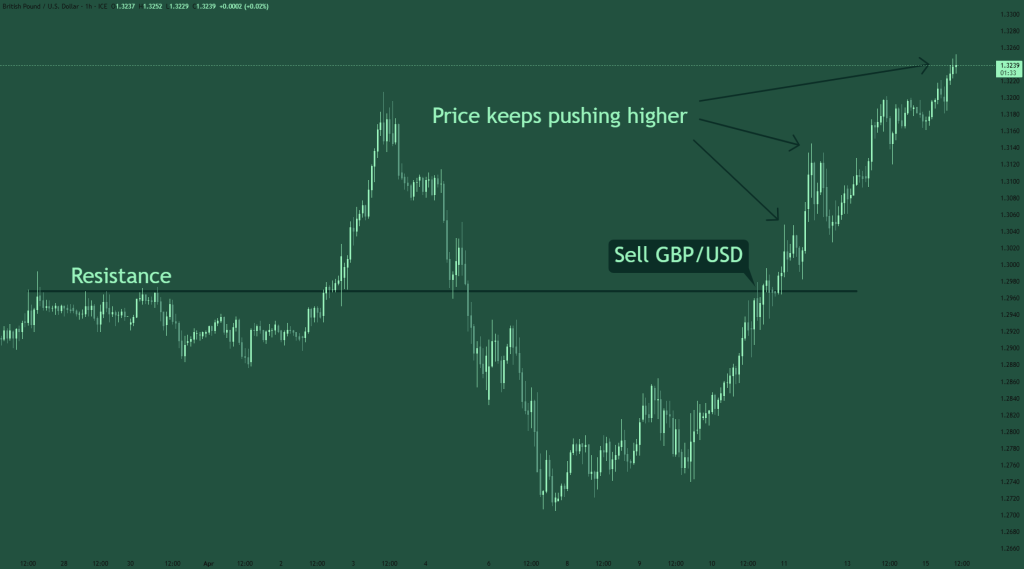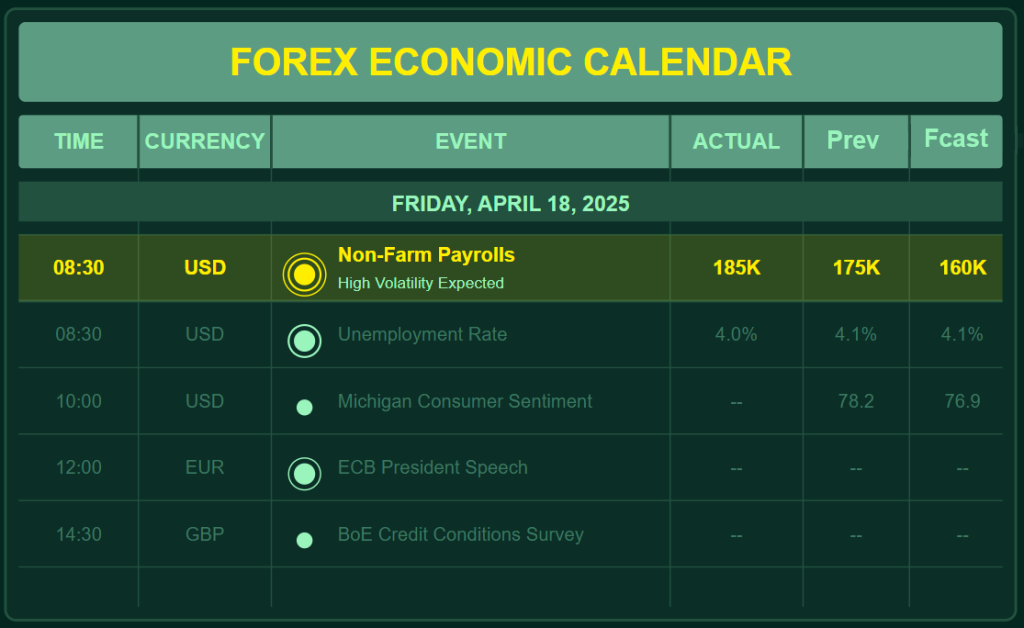Mar 25, 2025 /Level: Beginners /Avg reading time: 10 minutes
Forex day trading isn’t just about buying low and selling high; it’s about navigating a complex, fast-moving landscape where timing, trading strategy, and discipline are everything. If you’re curious about day trading forex and all the buzz around it, you landed in the right place.
This article isn’t about get-rich-quick schemes, it is your lifeline, helping you dodge 5 serious trading pitfalls that can sink even the most enthusiastic beginner day traders. And, we’ll explore how a prop firm like Leverage can provide a structured environment to help you avoid these very mistakes.
What is Day Trading for Beginners?
Forex day trading involves opening and closing positions within the same trading day, taking advantage of short-term price movements in the financial market. Intraday trading, particularly in the Forex market, is all about speed – turning small price fluctuations into potential profits. But, be warned, you need a robust day trading strategy to speculate during active market hours and ensure all trades are closed before the day’s end. Without it, you’re essentially gambling.
So, are you ready to learn how to navigate the volatility of the Forex market and avoid five costly mistakes that can drain your trading account faster than you can say “margin call”? Because in the fast-paced world of forex day trading, knowing what not to do is half the battle.
Your First Steps in Day Trading Forex
When you jump into day trading forex, you’re laser-focused on what makes the market tick within that very day. Forget about long-term forecasts; it’s all about the here and now. This is very different from position trading and swing trading.
So, what are the key ingredients you need to consider before you even think about placing a day trade?
Let’s take a look:
- Liquidity: Ever tried to sell something nobody wants? That’s low liquidity, and it’s a nightmare for day traders. Liquidity, in the Forex world, means how easily you can jump in and out of a trade without causing a massive price shift. High liquidity is your best friend; it allows you to smoothly make many trades during a single day.
- Volatility: Volatility is simply how much a currency pair’s price jumps around. For intraday trading, a bit of “storm” (volatility, that is) is actually good!
- Trading Volume: It shows how many times a currency pair is being bought and sold during the day.
- Market Hours and Trading Sessions: The Forex market is a 24/5 beast, but it doesn’t roar at full volume all the time. It’s divided into major sessions: Sydney, Tokyo, London, and New York.
Understanding when the Forex market is most active is crucial for intraday trading. Unlike stock markets, Forex operates 24 hours a day, five days a week. This is because it’s a global, decentralized market.
However, it’s not equally busy all the time: The London session (8 AM–5 PM GMT) is high liquidity, especially when overlapping with the New York trading session (1 PM–5 PM GMT) is when liquidity, volatility, and trading volume tend to explode and EUR/USD and GBP/USD currency pairs experience the biggest intraday price swings.
Pro Tip: Trade during overlapping sessions (London/New York) for maximum trading volume and smoother price action.
More volume = tighter spreads = better entries/exits.
This is something you’ll learn to master, and practicing within a structured environment, like Leverage’s simulation, can accelerate your understanding.
Key Strategies for Successful Forex Day Trading
So, you’ve got the basics down: liquidity, volatility, volume, and those all-important trading sessions. But knowing what to look for is only half the battle. You need a plan – a trading strategy – to turn that knowledge into action. Think of these trading strategies as your toolbox, each tool designed for a specific situation.
And remember, finding the right strategy, and proving it works consistently, is a key requirement for success with a prop firm like Leverage.

Here are a few popular day trading forex approaches day traders use:
- Scalping: Scalpers aim to make many tiny profits from very small price movements. They’re in and out of trades in minutes, sometimes even seconds.
- Momentum Trading: Momentum traders look for currency pairs that are moving strongly in one direction and jump on board, hoping to profit from the continued momentum. It’s like catching a trend before it fades. Key indicators here include moving averages and the Relative Strength Index (RSI).
- Breakout Trading: Imagine a currency pair’s price bouncing between two levels, like a ball trapped in a box. Breakout traders wait for the price to “break out” of that box, either upwards or downwards, and then enter a trade in the direction of the breakout.
- News Trading: News traders use an economic calendar to day trade and speculate on the impact that risk events may have on the price action.
- Reversal Trading: Reversal traders look for signs that a trend is about to change direction and try to profit from that shift. It’s like betting against the crowd, hoping to be right when everyone else is wrong. This requires a keen eye for candlestick patterns and indicators that signal a potential reversal.
5 Common Forex Day Trading Mistakes (and How to Avoid Them)
Forex day trading can be highly rewarding, but it’s also fraught with risks, and even experienced traders can fall into these common, yet costly, errors. Let’s break down five critical mistakes, explain why they’re harmful, and, more importantly, how to sidestep them, turning potential losses into learning opportunities. We’ll also touch on how a prop firm like Leveraged can help you avoid some of these pitfalls.

Mistake #1: Trading Without a Plan (and Sticking to It!)
Jumping into trades based on gut feelings, “hot tips,” or chasing fleeting price movements without a predefined trading strategy. This is essentially gambling, not trading. Many beginner forex traders get caught up in the excitement and make impulsive trading decisions, which often leads to inconsistent results.
Why It’s Costly:
Without a trading plan, you’re at the mercy of market whims. You lack clear entry and exit points, proper risk management, and a consistent approach. This leads to inconsistent results, emotional decision-making, and, ultimately, significant losses. You’ll likely overtrade, chase losses, and blow up your trading account.
How to Avoid It:
Develop a day trading strategy based on technical analysis, fundamental analysis, or a combination of both. But most importantly, test your strategy using real money to get comfortable making rapid decisions even if that means making small profits.
One of the biggest advantages of a prop firm like Leveraged is that it forces you to trade with a trading plan. The simulation phase requires you to demonstrate a consistent, profitable strategy before you’re given access to a funded account. This built-in structure prevents impulsive trading.
Example:
You hear a rumor that the USD/JPY pair is about to surge, so you enter a trade without analyzing the charts or considering your trading strategy. The rumor turns out to be false, and the market moves against you. Had you followed your own trading strategy, you might have avoided this trade altogether.

Mistake #2: Ignoring Risk Management
Risking too much per trade, failing to use stop-loss orders, or letting losing trades run in the hope they’ll “turn around” is the fastest way to destroy your trading capital.
Why It’s Costly:
Forex markets are volatile and even the best strategies have losing trades. Without proper risk management, a single bad trade, or a series of small losses, can wipe out a significant portion of your trading account, making it difficult or impossible to recover.
How to Avoid It:
Implement the 1-2% Rule meaning you never risk more than 1-2% of your total trading capital on any single trade. If you have a $1,000 account, your maximum risk per trade should be $10 – $20.
Leveraged has strict risk management rules. For example, Leveraged’s Senior Portfolio Manager program has a 4% daily loss limit and a 10% maximum loss limit. These limits protect both the trader and the firm’s capital, preventing catastrophic losses.
Example:
You decide to trade GBP/USD without setting a stop-loss. The market moves against you, and instead of cutting your losses, you hold onto the trade, hoping it will reverse. By the time you exit, you’ve lost 5% of your account. A stop-loss order could have limited your loss to 1%.

Mistake #3: Overtrading
Taking too many trades, often driven by boredom, a desire to “make up” for losses, or a feeling that you’re “missing out” (FOMO trading) on trading opportunities. This leads to poor trade selection and taking unnecessary too many trades.
Why It’s Costly:
Every trade has a cost (spread or commission). Overtrading eats into your profits, even if you have some winning trades. It also leads to mental fatigue and poor decision-making, increasing the likelihood of trading mistakes.
How to Avoid It:
One of the most effective solutions is to set a daily limit on the number of trades you’ll execute. While Leveraged doesn’t explicitly limit the number of trades, the simulation phase encourages quality over quantity. Traders need to achieve specific profit targets while staying within risk limits, promoting a more disciplined approach.
Example:
Imagine you’re day trading the EUR/USD pair during the London session. You’ve already made two profitable trades, but you notice another potential setup. Instead of sticking to your plan, you jump into a third trade out of excitement. The market reverses, and you end up losing all your earlier gains. By limiting yourself to two trades per day, you could have avoided this loss.
Mistake #4: Neglecting Economic News and Events
Ignoring scheduled economic news releases (e.g., interest rate decisions, employment reports, GDP data) or major geopolitical events that can significantly impact currency prices.
Why It’s Costly:
Major news releases can cause sudden, sharp price movements (spikes in volatility). If you’re in a trade without being aware of an upcoming release, you could be caught on the wrong side of a large move, leading to a significant trading loss.
How to Avoid It:
A simple fix is to use an economic calendar: Websites like Forex Factory, Investing.com, and DailyFX provide economic calendars that list upcoming news releases and their expected impact.
Leveraged explicitly prohibits trading during high-impact news events (within 5 minutes before and after). This rule protects traders from the unpredictable volatility associated with these releases.
Example:
The US Non-Farm Payrolls (NFP) report is released on the first Friday of every month. This is a major economic indicator that often causes significant volatility in the USD pairs. If you’re holding a USD position without being aware of the NFP release, you could be caught off guard by a sudden price movement.

Mistake #5: Failing to Adapt and Learn (The Stagnation Trap)
Sticking rigidly to a single day trading system, even when it’s consistently losing money, or failing to review your trades and identify areas for improvement.
Why It’s Costly:
What works today might not work tomorrow, especially with forex day trading. If you’re not constantly learning and adapting, you’ll fall behind. Failing to analyze your trading mistakes means you’re doomed to repeat them.
How to Avoid It:
Record every day trade you take in a trading journal, including the rationale behind it, the entry/exit points, the outcome, and any lessons learned. Leveraged provides AI-powered tools and feedback to help traders analyze their performance and identify areas for improvement. This encourages continuous learning and adaptation, crucial for long-term success.
Example:
You’ve been using a scalping strategy for a month, and you’re consistently losing money. Instead of stubbornly sticking with it, you review your trading journal and realize that you’re often getting stopped out by small price fluctuations. You decide to try a different strategy, such as momentum day trading, which might be better suited to your trading style and the current market conditions.
Don’t let common mistakes derail your forex day trading journey. Click the button below to learn more about the Leveraged simulation and start your path to becoming a funded forex day trader!
FAQ – Forex Day Trading
Is day trading in forex profitable?
Yes, day trading in forex can be profitable, but it’s crucial to understand that it’s not a guaranteed path to riches. Profitability depends on a combination of factors, including:
- A robust day trading strategy
- Disciplined execution
- Effective risk management
- Continuous learning and adaptation
- Emotional control
Do I need $25,000 to day trade forex?
No, you do not need $25,000 to day trade forex. The $25,000 rule (Pattern Day Trader rule) applies to margin accounts for trading stocks in the US, not to forex trading. Forex brokers typically offer much higher leverage, allowing you to control larger positions with a smaller initial deposit. However, starting with a very small account can limit your trading opportunities and make it harder to manage risk effectively.
Is $500 enough to trade forex?
Yes, you can start day trading with $500 but while $500 is a starting point, increasing your capital over time will allow you to take larger positions and potentially increase your profits. This is where a prop firm like Leveraged can be beneficial, providing access to larger capital after you’ve proven your trading skills.
What are the best forex day trading indicators?
There’s no single “best” indicator for forex day trading, as the effectiveness of an indicator depends on your chosen trading style, the currency pair, and market conditions. However, some popular and widely used indicators include:
- Moving Averages (MA)
- Relative Strength Index (RSI)
- MACD indicator
- Bollinger Bands
- Fibonacci Retracements
- Stochastic Oscillator